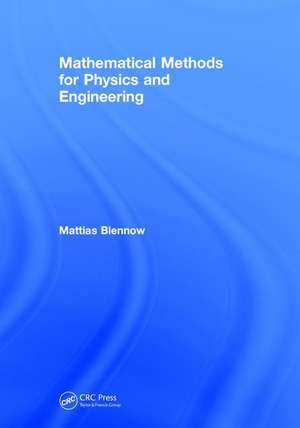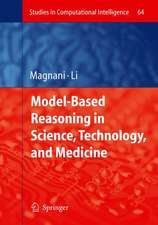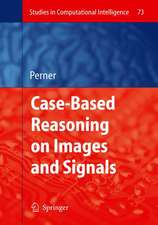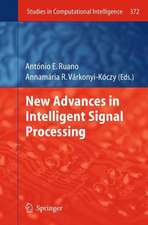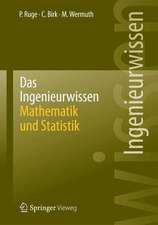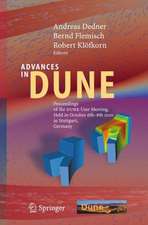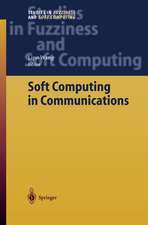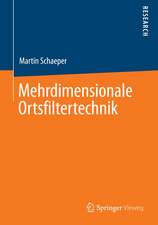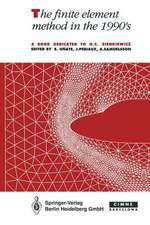Mathematical Methods for Physics and Engineering
Autor Mattias Blennowen Limba Engleză Hardback – 6 dec 2017
| Toate formatele și edițiile | Preț | Express |
|---|---|---|
| Paperback (1) | 809.82 lei 43-57 zile | |
| CRC Press – 18 dec 2017 | 809.82 lei 43-57 zile | |
| Hardback (1) | 1404.44 lei 43-57 zile | |
| CRC Press – 6 dec 2017 | 1404.44 lei 43-57 zile |
Preț: 1404.44 lei
Preț vechi: 1894.10 lei
-26% Nou
Puncte Express: 2107
Preț estimativ în valută:
268.82€ • 292.10$ • 225.96£
268.82€ • 292.10$ • 225.96£
Carte tipărită la comandă
Livrare economică 21 aprilie-05 mai
Preluare comenzi: 021 569.72.76
Specificații
ISBN-13: 9781138056909
ISBN-10: 1138056901
Pagini: 760
Ilustrații: 247 Illustrations, black and white
Dimensiuni: 178 x 254 x 50 mm
Greutate: 0.45 kg
Ediția:1
Editura: CRC Press
Colecția CRC Press
ISBN-10: 1138056901
Pagini: 760
Ilustrații: 247 Illustrations, black and white
Dimensiuni: 178 x 254 x 50 mm
Greutate: 0.45 kg
Ediția:1
Editura: CRC Press
Colecția CRC Press
Public țintă
Postgraduate and UndergraduateCuprins
Scalars and Vectors. Tensors. Partial Differential Equations and Modelling. Symmetries and Group Theory. Function Spaces. Eigenfunction Expansions. Green’s Functions. Variational Calculus. Calculus on Manifolds. Classical Mechanics and Field Theory. Reference material. Summaries of Chapters.
Recenzii
Many of my favorite reference texts manage to resolve a paradox : how to provide an original presentation of well-established material? For example, both "The Feynman Lectures" (Richard Feynman) and "Introduction to Error Analysis" (John Taylor) are justifiably well-known because of their idiosyncratic approach to the subject at hand. There are other, similarly engaging texts, and I’m pleased to describe a new addition to my list, "Mathematical Methods for Physics and Engineering" by Mattias Blennow.
Prof. Below has written a text that will compete in a crowded field; ‘standard texts’ such as those by Boas, Shankar, and Arfken are well-known and widely adopted. However, Blennow’s text offers much that substantially improves upon these others and deserves serious consideration for textbook adoption. The intended audience is likely an advanced undergraduate or introductory graduate course in Physics or Engineering departments, and the worked examples and end-of-chapter problems bear this out. The overall focus of this book is to apply mathematical tools (for example, eigenfunction expansions) to solve physics and engineering problems.
Personally, several chapters stand out: Chapter 4 (Group theory) is the friendly introduction that I have long sought. Example problems are particularly well-chosen and insightful. Similarly, Chapter 7 (Green’s Functions) contains material that does not appear to be available outside of specialized mathematics texts. Another highlight includes a particularly clear discussion about Sturm-Liouville problems in Chapter 5.
The end-of-chapter problems are well considered and span a wide range of difficulty, making them suitable for homework problems. I strongly recommend that anyone teaching an advanced undergraduate or early graduate class on "Mathematical Methods for Physics" peruse this book and consider using it.
-Andrew Resnick, Associate Professor, Department of Physics, Cleveland State University
Most math textbooks focus on math itself (e.g. proving a theorem strictly) and do not connect math with physics, making them not very useful for physicists, chemists, or engineers. Books that emphasize the "application" aspect of math will be of great value to these readers but are unfortunately rare to find, especially in the form of textbook instead of general reference/manual. This book does a nice job towards filling the gap. I envision that students who major in physics and engineering, especially those who are interested in gaining good understanding of the theoretical aspects of physics, will like this book.
- Prof. Dr Hai Lin, University of Colorado Denver
I wish I had this book available as an advanced undergraduate and graduate student of physics. The challenge for both a student and a teacher of physics is that usually the mathematics one needs in the physics or engineering standard course lectures is not yet avaialable. Here one finds the material presented in a very intuitive way, with an emphasis on how the concepts are applied to calculations in physics. The concepts themselves are introced using typical examples for their use in physics. This does not only include the usual vector and calculus, partial differential equations, and special functions, but also a very valuable introduction to group and group-representation theory, whose importance for physics cannot be overestimated. The book also covers functional analysis, variational calculus, and differential geometry on manifolds. This provides a rather complete mathematical basis for all the standard subjects of the physics and engineering curriculum from classical point and continuum mechanics and electrodynamics to quantum mechanics and general relativity. and thus it is not only a textbook for students and teachers but also a valuable reference work for any user of mathematical methods in the natural and engineering sciences.
- Hendrik van Hees PD, Insitute for Theoretical Physics, Goethe University Frankfurt am Main.
This book is a comprehensive introduction to mathematical methods most widely used by physicists and engineers. It is written with a great pedagogic skill and contains a large number of carefully selected and thoroughly worked-out examples, which serve as a perfect illustration of the presented material and facilitate its mastering. The many problems given at the end of each chapter will help the reader to further improve his or her practical command of the material. Compared to other similar books, it is more accessible to undergraduate-level students as it does not rely on examples based on advanced topics, such as quantum mechanics. The book can serve as a textbook as well as a handy reference book. Highly recommended.
- Evgeny Akhmedov, Staff member at the Max Planck Institute for Nuclear Physics, Heidelberg and Senior Research Scientist at the Kurchatov Institute of Atomic Energy, Moscow
Prof. Below has written a text that will compete in a crowded field; ‘standard texts’ such as those by Boas, Shankar, and Arfken are well-known and widely adopted. However, Blennow’s text offers much that substantially improves upon these others and deserves serious consideration for textbook adoption. The intended audience is likely an advanced undergraduate or introductory graduate course in Physics or Engineering departments, and the worked examples and end-of-chapter problems bear this out. The overall focus of this book is to apply mathematical tools (for example, eigenfunction expansions) to solve physics and engineering problems.
Personally, several chapters stand out: Chapter 4 (Group theory) is the friendly introduction that I have long sought. Example problems are particularly well-chosen and insightful. Similarly, Chapter 7 (Green’s Functions) contains material that does not appear to be available outside of specialized mathematics texts. Another highlight includes a particularly clear discussion about Sturm-Liouville problems in Chapter 5.
The end-of-chapter problems are well considered and span a wide range of difficulty, making them suitable for homework problems. I strongly recommend that anyone teaching an advanced undergraduate or early graduate class on "Mathematical Methods for Physics" peruse this book and consider using it.
-Andrew Resnick, Associate Professor, Department of Physics, Cleveland State University
Most math textbooks focus on math itself (e.g. proving a theorem strictly) and do not connect math with physics, making them not very useful for physicists, chemists, or engineers. Books that emphasize the "application" aspect of math will be of great value to these readers but are unfortunately rare to find, especially in the form of textbook instead of general reference/manual. This book does a nice job towards filling the gap. I envision that students who major in physics and engineering, especially those who are interested in gaining good understanding of the theoretical aspects of physics, will like this book.
- Prof. Dr Hai Lin, University of Colorado Denver
I wish I had this book available as an advanced undergraduate and graduate student of physics. The challenge for both a student and a teacher of physics is that usually the mathematics one needs in the physics or engineering standard course lectures is not yet avaialable. Here one finds the material presented in a very intuitive way, with an emphasis on how the concepts are applied to calculations in physics. The concepts themselves are introced using typical examples for their use in physics. This does not only include the usual vector and calculus, partial differential equations, and special functions, but also a very valuable introduction to group and group-representation theory, whose importance for physics cannot be overestimated. The book also covers functional analysis, variational calculus, and differential geometry on manifolds. This provides a rather complete mathematical basis for all the standard subjects of the physics and engineering curriculum from classical point and continuum mechanics and electrodynamics to quantum mechanics and general relativity. and thus it is not only a textbook for students and teachers but also a valuable reference work for any user of mathematical methods in the natural and engineering sciences.
- Hendrik van Hees PD, Insitute for Theoretical Physics, Goethe University Frankfurt am Main.
This book is a comprehensive introduction to mathematical methods most widely used by physicists and engineers. It is written with a great pedagogic skill and contains a large number of carefully selected and thoroughly worked-out examples, which serve as a perfect illustration of the presented material and facilitate its mastering. The many problems given at the end of each chapter will help the reader to further improve his or her practical command of the material. Compared to other similar books, it is more accessible to undergraduate-level students as it does not rely on examples based on advanced topics, such as quantum mechanics. The book can serve as a textbook as well as a handy reference book. Highly recommended.
- Evgeny Akhmedov, Staff member at the Max Planck Institute for Nuclear Physics, Heidelberg and Senior Research Scientist at the Kurchatov Institute of Atomic Energy, Moscow
Descriere
Suitable for advanced undergraduate and graduate students, this new textbook contains an introduction to the mathematical concepts used in physics and engineering. It provides the student with the tools needed for advanced topics, such as quantum mechanics and general relativity, while offering examples and insights into classical physics.
